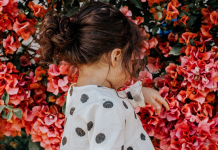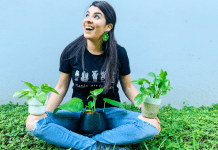One of the first things we did when we moved out of condo living into a house was start our butterfly garden. My daughter was around two years old (she is now four and a half), and since then butterfly season is her favorite time spent outdoors. You would be surprised at how much something like this will grow your children’s interest in nature.

Spring is the perfect time for garden activities. For this reason, procuring butterfly host plants will attract butterflies. Inviting butterflies into your landscape and watching their fluttering wings and the life cycle they create can in turn be quite magical. With many of the plants on this guide, you will find an opportunity to educate your children about the life cycle of a butterfly. Furthermore, experiencing first-hand a butterfly’s cycle from the stages of egg, caterpillar, chrysalis, and then butterfly. This allows children to see the relationships between insects and plants.
Let’s get ready to find the perfect plants to start your butterfly garden!

Milkweeds
If you are exploring to begin your very own butterfly garden, milkweed plants will be your go-to. Milkweeds come in a variety of colors. The flowers are beautiful and you will almost always see caterpillars or a monarch butterfly perched drinking nectar or laying eggs. They are also very easy to purchase in South Florida and extremely hardy. For this reason, milkweeds have become a family favorite in our garden.

Flower Characteristics
Milkweeds typically produce star-shaped flowers that are excellent for pollination. They bloom in a variety of colors, including yellow, orange, white, pink, purple, and green. As a result, they are a great choice if you want a nice variety of colors in your garden.

Hosts
The monarch and queen butterflies love to lay their eggs on milkweed. Therefore, you will find that the eggs are on the underside of the leaves.

Height
Two to five feet, depending on the species of milkweed.
Passiflora (Passion Flowers)
Passiflora plants, especially the Passiflora Incarnata, Passiflora Suberosa, or Passiflora Lutea bloom between April and September. These plants have an exotic appeal and are fast-growing.
Flower Characteristics
Flowers are fragrant and fringed. The plant climbs through its vines with grasping tendrils. Consequently, they can become quite invasive. You can find blooms in a variety of shades, including blue, purple, pink, orange, red, yellow, and white.

Hosts
Gulf fritillary, Julia, and our very own state butterfly the zebra longwing. Eggs can be found all along the plant and many times on its climbing tendrils.

Height
Six to ten feet, depending on the species of passiflora.
Senna
Senna plants are very popular host plants in butterfly gardens. This hardy and fast-growing plant blooms from mid to late summer. Aside from attracting butterflies, you may find some birds helping themselves to the seedpods.

Flower Characteristics
Blooms have clusters of yellow flowers.

Hosts
Cloudless sulphur, orange-barred sulphur, and sleepy orange butterflies.

Height
Four to six feet.
Wild Lime
Unlike other plants on this guide, wild lime is a native tree that thrives in South Florida’s climate and blooms year-round. We love the smell of its foliage and the fact that it is drought tolerant.
Flower Characteristics
Flowers are tiny and vary from yellow to a yellowish-green.
Hosts
Giant swallowtail and schuss swallowtail butterflies.

Height
Six to twelve feet.
Butterfly season commonly starts in April with its peak during the summer in June. For this reason, now is the time to get outdoors and pick a location that receives six to eight hours of sunlight and is sheltered from wind. Select your plants as a family and start planting!

Within a few days or weeks, you will begin to see some friendly wings. After that be ready to see some eggs and begin the amazing butterfly cycle.

Gardening is a great family hobby! Have you started your butterfly garden? Do you have a favorite butterfly host plant? Leave us a comment below! We would love to hear from you.

















I LOVE this!!!!!
Such a great post! Can’t wait to get more butterflies in!
The many articles I have read from scientists agree that Asclepias CURASSAVICA is not a native milkweed and should not be used. It spread a disease to migratory monarchs and is not as nutritious it also blooms all year here in Florida so it interferes with migratory patterns. I have read only one article that disputes that. Other types of milkweed (i.e. swamp and butterfly weed and a couple others in the Asclepias family). The harmful variety is readily available at Lowe’s, Home Depot, etc. But should not be used. I started out with this type milkweed and was very successful in producing but have pulled them all up and now use only native milkweed varieties. Just thought you might want to research this a bit.
Comments are closed.